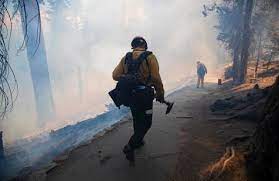David G. Victor & Veerabhadran Ramanathan
Last month, we heard yet again about the need to stop global warming at about 1.5 degrees centigrade above preindustrial levels. The International Energy Agency outlined a plan to meet that goal, and the United Nations secretary-general implored nations to get serious about cutting emissions to make it a reality.
That goal is a fantasy. This summer, global warming already yielded monthly average temperatures that exceeded preindustrial averages by 1.5 degrees. It took more than a century for global annual average temperatures to reach the first degree, which happened around 2015. Climate data suggest that the next half-degree is likely to happen by the early 2030s, if not sooner, and that 2023 will be the warmest year on record. The reality of rapid warming requires that every country create an adaptation strategy to become more resilient to the effects of climate change. Adaptation means lessening the harm caused by storm surges, floods, heat waves, fires and other weather-related perils. It requires new infrastructure, early warning systems and better awareness of how changes in the climate will harm things we value. The best adaptation strategies go further to pursue resilience – the ability to bounce back from destructive changes.
Adaptation to the consequences of global warming doesn’t come just from singular activities, like flipping a switch; it’s processes that will affect all of society and can easily go awry. Similarly, a serious resilience strategy can’t be piecemeal: It involves power grids and other infrastructure that must be managed at a large scale, and every locality needs to learn from ideas that get tested around the country and world. That’s why we need a national approach that assesses how local efforts fit together, how much money to spend on each component and which policies actually work. The US currently invests far too little in adaptation projects and has no comprehensive national adaptation strategy. The unprecedented climate spending in two recent laws – the Bipartisan Infrastructure Law and the Inflation Reduction Act – is long overdue. But they primarily focus on reducing emissions, devoting a small fraction of total spending to resilience and adaptation. Even California, a national leader on climate issues, last year allocated only about one-fifth of its multiyear climate budget to resilience efforts such as shoring up the water system against drought. This year, with a tighter budget overall, that proportion is declining. A national adaptation and resilience strategy would help states, in addition to the federal government, set goals for the right spending to ensure effective adaptation while also aggressively cutting emissions.
Any national approach will, of course, build on adaptation projects that localities are pursuing. California and its electric utilities have learned how to reduce the risk of wildfires by cutting power to fire-prone areas, clearing brush, hardening power lines and experimenting with new control systems. The Southwest is, belatedly, planning for a more parched future by seeking new sources of water, investing in ways to purify wastewater and seawater, requiring more frugal water use, managing snowpack runoff more efficiently and reallocating water from the region’s crucial river, the Colorado. Miami is building artificial reefs that can help blunt waves and wind during storms. New York, battered by Superstorm Sandy in 2012 and hit recently by floods, has strengthened its defenses such as seawalls and subway floodgates. Houston and New Orleans are bracing for more frequent and severe flooding by improving seawalls and stormwater systems. The federal government must knit these scattered efforts into a coherent national approach. It is starting to shift its behavior – slightly. The Federal Emergency Management Agency is putting more resources toward disaster resilience and has raised federal insurance premiums, including an increase in rates for flood insurance, to better reflect real risks. The Pentagon is, among other efforts, working to protect military bases from rising seas and stronger storms and building microgrids to insulate bases’ electric supply against climate-related interruptions. These actions are important. But they remain isolated around the country and limited to government, still failing to consider the system as a whole. For example, because the climate can change in unexpected and dangerous ways, it’s important to run stress tests – such as assessing how stronger storms could affect supply chains that in turn affect the economy – much as central bankers periodically look at extreme economic events.
Five years ago we predicted, with a colleague, what’s confirmed in today’s news: that warming rates would accelerate. That prediction was not taken seriously at the time because the scientific consensus was that warming would happen more slowly. If the country had a national adaptation strategy that included stress tests, we could have assessed how outlier predictions such as ours – which often come to pass in climate science, since the consensus leans conservative – would affect the country. In 2019, a commission co-chaired by Bill Gates, former UN Secretary-General Ban Ki-moon and International Monetary Fund Managing Director Kristalina Georgieva reported that a $1.8-trillion investment in adaptation worldwide could generate $7.1 trillion in benefits by 2030, including by creating more jobs in vulnerable communities. At the global level, the populations most vulnerable to rapid warming include about 3 billion people who are contending with poverty, fragile housing, scarce affordable clean energy and other challenges. Although these communities contribute just a tiny fraction of the carbon emissions that cause global warming, the world is spending billions more on getting them to reduce those emissions than on the more urgent goal of helping them adapt to the impacts. On the national level, we don’t even have estimates on how much money the federal government could save by investing more in adaptation than in rebuilding communities after they’ve been demolished by extreme weather events. Even with a global crash program to cut emissions – which is essential – climate change will worsen for at least the next two decades. We need national strategies that can help us bounce back from increasingly devastating hits.
The Los Angeles Times







